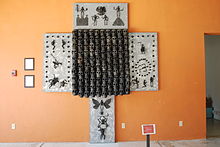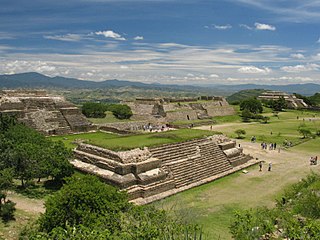
Oaxaca de Juárez, or simply Oaxaca, is the capital and largest city of the eponymous Mexican state of Oaxaca. It is the municipal seat for the surrounding municipality of Oaxaca. It is in the Centro District in the Central Valleys region of the state, in the foothills of the Sierra Madre at the base of the Cerro del Fortín, extending to the banks of the Atoyac River.

Alebrijes are brightly colored Mexican folk art sculptures of fantastical (fantasy/mythical) creatures.

Barro negro pottery is a style of pottery from Oaxaca, Mexico, distinguished by its color, sheen and unique designs. Oaxaca is one of few Mexican states which is characterized by the continuance of its ancestral crafts, which are still used in everyday life. Barro negro is one of several pottery traditions in the state, which also include the glazed green pieces of Santa María Atzompa; however, barro negro is one of the best known and most identified with the state. It is also one of the most popular styles of pottery in Mexico. The origins of this pottery style extends as far back as the Monte Albán period. For almost all of this pottery's history, it had been available only in a grayish matte finish. In the 1950s, a potter named Doña Rosa devised a way to put a black metallic-like sheen onto the pottery by polishing it before firing. This look has increased the style's popularity. From the 1980s to the present, an artisan named Carlomagno Pedro Martínez has promoted items made this way with barro negro sculptures which have been exhibited in a number of countries.
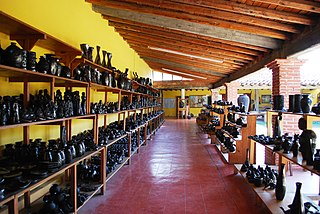
San Bartolo Coyotepec is a town and municipality located in the center of the Mexican state of Oaxaca. It is in the Centro District of the Valles Centrales region about fifteen km south of the capital of Oaxaca.

The Museo de Arte Popular is a museum in Mexico City, Mexico that promotes and preserves part of the Mexican handcrafts and folk art. Located in the historic center of Mexico City in an old fire house, the museum has a collection which includes textiles, pottery, glass, piñatas, alebrijes, furniture and much more. However, the museum is best known as the sponsor of the yearly, Noche de Alebrijes parade in which the fantastical creatures are constructed on a monumental scale and then paraded from the main plaza or Zocalo to the Angel of Independence monument, competing for prizes.

Ceramics in Mexico date back thousands of years before the Pre-Columbian period, when ceramic arts and pottery crafts developed with the first advanced civilizations and cultures of Mesoamerica. With one exception, pre-Hispanic wares were not glazed, but rather burnished and painted with colored fine clay slips. The potter's wheel was unknown as well; pieces were shaped by molding, coiling and other methods,
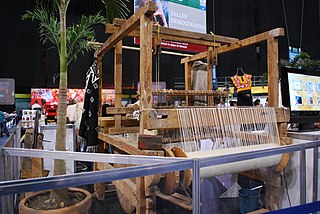
The Fondo Nacional para el Fomento de las Artesanías or National Fund for the Development of Arts and Crafts is a dependence of the Secretariat of Social Development (SEDESOL). It was established in 1974 to promote and protect traditional Mexican handcrafts. The agency has four main programs including artisan training, retail selling and the sponsoring of craft competitions as the local, regional and national level. FONART directly helped 26,600 artisans in 2006, but the agency has been criticized for being inefficient and not meeting the demands of national transparency laws. Currently, it seeks the capacity to authenticate crafts on a national and international level due to competitions from imitations from Asia.

Museo Universitario de Artes Populares María Teresa Pomar is a museum dedicated to Mexico's handcrafts and folk art tradition, called “artesanía.” It is part of the University of Colima in the city of Colima, founded by artesanía collector and promoter María Terea Pomar. It contains one of the most important collections of its type in Mexico, covering traditions from around the country as well as the artesanía and traditions of the state of Colima.

The Museo Regional de la Cerámica in Tlaquepaque, Jalisco, Mexico is located on Independencia Street in the center of the city. The museum is one of two main ceramics museums in the city, with the other being the Pantaleon Panduro Museum. It was established in 1954 to preserve and promote indigenous handcrafts of Jalisco, especially the state’s ceramic tradition. The emphasis is still on ceramics but the museum also has a room dedicated to Huichol art and holds events related to various types of indigenous crafts and culture.

Carlomagno Pedro Martínez is a Mexican artist and artisan in “barro negro” ceramics from San Bartolo Coyotepec, in the Mexican state of Oaxaca. He comes from a family of potters in a town noted for the craft. He began molding figures as a child and received artistic training when he was 18. His work has been exhibited in Mexico, the U.S. and Europe and he has been recognized as an artist as well as an artisan. Today, he is also the director of the Museo Estatal de Arte Popular de Oaxaca (MEAPO) in his hometown. In 2014, Martínez was awarded Mexico's National Prize for Arts and Sciences

Doña Rosa, full name Rosa Real Mateo de Nieto, was a Mexican ceramics artisan from San Bartolo Coyotepec, Oaxaca, Mexico. She is noted for inventing a technique to make the local pottery type, barro negro, black and shiny after firing. This created new markets for the ceramics with collectors and tourists.
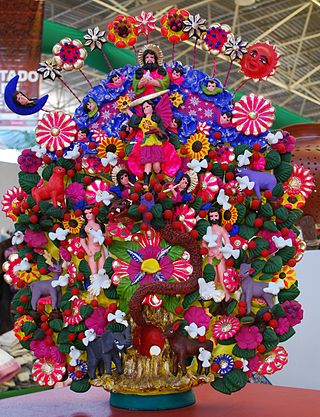
The pottery of Metepec is that of a municipality in central Mexico, located near Mexico City. It is noted for durable utilitarian items but more noted for its decorative and ritual items, especially sculptures called “trees of life,” decorative plaques in sun and moon shapes and mermaid like figures called Tlanchanas. Metepec potters such as the Soteno family have won national and international recognition for their work and the town hosts the annual Concurso Nacional de Alfarería y Cerámica.
Friends of Oaxacan Folk Art is a non-profit organization dedicated to promoting the traditional handcrafts and folk art of the Mexican state of Oaxaca, especially to encourage young artisans to continue family and regional traditions.

Oaxaca handcrafts and folk art is one of Mexico's important regional traditions of its kind, distinguished by both its overall quality and variety. Producing goods for trade has been an important economic activity in the state, especially in the Central Valleys region since the pre-Hispanic era which the area laid on the trade route between central Mexico and Central America. In the colonial period, the Spanish introduced new raw materials, new techniques and products but the rise of industrially produced products lowered the demand for most handcrafts by the early 20th century. The introduction of highways in the middle part of the century brought tourism to the region and with it a new market for traditional handcrafts. Today, the state boasts the largest number of working artisans in Mexico, producing a wide range of products that continue to grow and evolve to meet changing tastes in the market.

Jacobo Angeles is a Mexican artisan from San Martín Tilcajete, Oaxaca who is known for his hand carved and distinctly painted alebrije figures. The town is noted for its production of these figures which generally are carvings of animals painted in bright colors and bold designs, and Angeles grew up carving the local wood they are made from. The artisan's work has become distinguished for the painting of fine, intricate designs over the base paint, often inspired by Zapotec and other indigenous designs. He works with his wife María del Carmen Mendoza, at the couple's home and workshop in their hometown. While Angeles continues to create alebrijes, much of the production of the workshop is done by younger members of the Angeles family, which is a tourist attraction in the town. Angeles travels frequently to promote alebrijes and Zapotec culture, especially in the United States, and his work has been shown in major venues in Mexico and abroad, as well as featured in two books. In 2014, he was invited to the Vatican to meet Pope Francis and set alebrije nativity scenes and Christmas tree ornaments.

Handcrafts and folk art in Mexico City is a microcosm of handcraft production in most of the rest of country. One reason for this is that the city has attracted migration from other parts of Mexico, bringing these crafts. The most important handcraft in the city is the working of a hard paper mache called cartonería, used to make piñatas and other items related to various annual celebrations. It is also used to make fantastic creatures called alebrijes, which originated here in the 20th century. While there are handcrafts made in the city, the capital is better known for selling and promoting crafts from other parts of the country, both fine, very traditional wares and inexpensive curio types, in outlets from fine shops to street markets.

Marta Turok is a Mexican applied anthropologist focusing on socio-economic development, and one of the foremost schools on Mexican folk art. Through research, government work, education and advocacy, she has worked to raise the prestige of Mexican handcrafts and folk art and to help artisans improve their economic status. Her work has been recognized with awards from various governmental and non-governmental agencies.

Tlaxcala handcrafts and folk art is that which comes from the smallest state in Mexico, located in the center-east of the country. Its best-known wares are the "canes of Apizaco", sawdust carpets and the making of Saltillo-style serapes. However, there are other handcraft traditions, such as the making of pottery, including Talavera type wares, cartoneria, metalworking and stone working. The state supports artisans through the activities of the Fideicomiso Fondo de la Casa de las Artesanía de Tlaxcala
Angélica Delfina Vásquez Cruz, also known as the Ceramista del Preciosismo, is a potter from Oaxaca, Mexico.



